#Battle of Fontenoy
Text
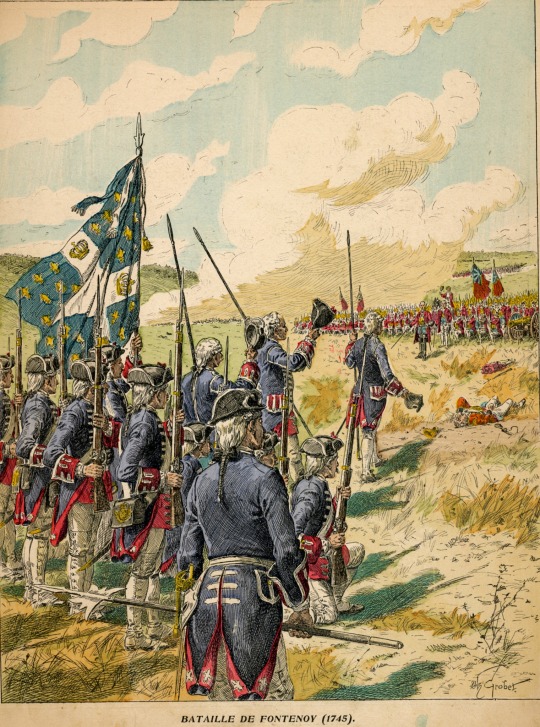
Battle of Fontenoy (1745) by Henri Grobet
#battle of fontenoy#art#henri grobet#war of the austrian succession#france#great britain#history#britain#england#french#english#british#marshal of france#dutch republic#hanover#holy roman empire#austrian netherlands#netherlands#lowlands#pay bas#belgium#austrian#europe#european#soldiers
34 notes
·
View notes
Photo
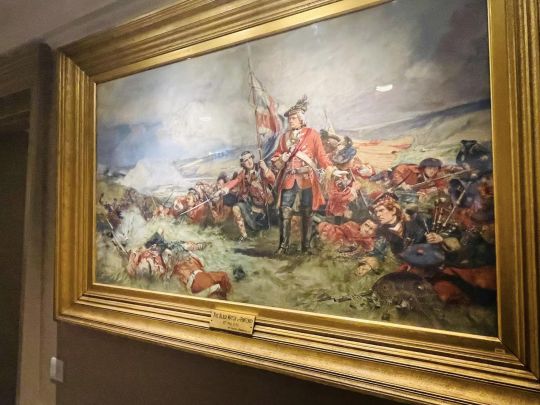


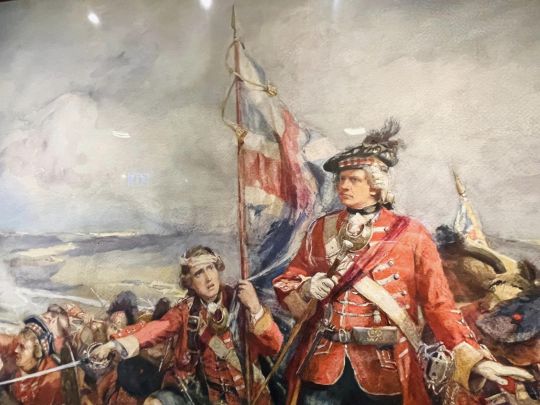
The Black Watch at the Battle of Fontenoy by William Skeoch Cumming. The battle was the first time a full regiment of highlanders fought in the British Army in Europe. They hugged the ground when the French fired at them before charging with their broadswords, all but the regiment’s commander, who was too overweight to lie down easily and chose to stand (the artist has been kind to him).
#fontenoy#battle of fontenoy#18th century#british army#redcoat#redcoats#scotland#scottish#highlander#highlanders#kilt#war of the austrian succession
18 notes
·
View notes
Text
#OTD in 1745 – At the Battle of Fontenoy, near Tourney in modern Belgium, the Irish Brigade of the French army under Lieutenant Charles O’Brien repulses the British and wins the day.
#OTD in 1745 – At the Battle of Fontenoy, near Tourney in modern Belgium, the Irish Brigade of the French army under Lieutenant Charles O’Brien repulses the British and wins the day.
The role of the Irish Brigade at the Battle of Fontenoy, where the French army won a notable victory over the British and Dutch, has been regarded as the greatest of Irish battle honours. However, this event is now largely forgotten, at least in this country. But that they once loomed very large in the Irish psyche explains a childhood address of James Joyce – Fontenoy Street in Dublin 7 – as…

View On WordPress
#Battle of Fontenoy#Belgium#Britain#British#Dutch#Fontenoy#France#Ireland#The Irish Brigade#Thomas Osborne Davis#Tourney
11 notes
·
View notes
Text
1745-Battle of Fontenoy

The Battle of Fontenoy was a major engagement of the War of the Austrian Succession, fought on 11 May 1745 near Tournai in modern Belgium. A French army of 50,000 under Marshal Saxe defeated a Pragmatic Army[f] of roughly the same size, led by the Duke of Cumberland
0 notes
Text
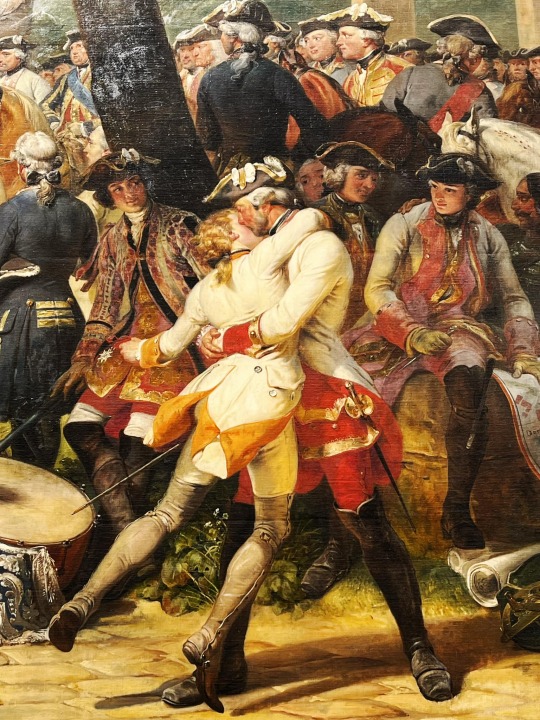
A young officer leaps into the arms of his father in this detail of the painting "Battle of Fontenoy" 1828 by Horace Vernet (1789-1863) Galerie des Batailles / Château de Versailles.
14 notes
·
View notes
Text

design for Jim's mom, and also some headcanons under the cut
jim's mother is in her late 30s at the time of the story
jim's dad and dr livesey were long-time close friends
as such dr livesey is a family friend of jim's and has been like an uncle figure for jim pretty much since he was born (might have even been the one helping jim's mom birth jim if thats not too weird)
even moreso when jim's father died in the Battle of Fontenoy where he and dr livesey were in the same unit
when jim's father died, ownership of the inn was passed on to jim, but he only formally owns it, his mother does all of the actual management and planning. he just cleans up and decks tables and such
jim's mom has always been pretty protective of her son but that amplified tenfold when she recieved the news of her husband's death
she is very strict with jim, constantly stressing the importance of good manners, hence why jim is such a soft spoken kind boy
her and dr livesey both imposed a lot of importance on health on jim as well. jim has very regular health check ups and of course does his exercise every morning and doesnt smoke or drink
above all else ms hawkins wants her boy to be safe, she is a big worrywart when it comes to him, since she doesn't want to lose anyone else in her family so soon (that includes dr livesey too, she moms him around quite a bit as well)
she was out of town when jim got visited by billy bones and subsequently invovled in the hunt for captain flint's treasure, buying supplies for the inn in shepperdine
(the admiral benbow inn is in newtown by the bristol channel btw)
ms hawkins semi-accurately believed her son was kidnapped and had a right proper mental breakdown
one of trelawney's servants informed her that jim has headed to bristol with the doctor and the squire which calmed her down just a little bit, but still left her wracked with nerves and anxiously waiting for their return
upon arriving back in england, dr livesey, trelawney and captain smollett personally escorted jim back home to make sure the boy safely gets there (also dr livesey remembered that ms hawkins would be back from her errands by now and knows she was gonna be PISSED so he wanted to resolve any potential misunderstandings as soon as possible)
ms hawkins reacted about as well as you would expect upon finding out her son was on a life-threatening adventure with pirates and casualties. she grabbed the three men and took them to another room whereupon she reprimanded them very vocally for the danger they put her son through

livesey manages to calm her down a little bit by repeatedly assuring her that jim is totally fine (minus the mental scars but those arent noticable yet) and that a majority of flint's treasure will be going towards her and the inn
also i want her and captain smollett to get together because i will take literally every oppertunity to put a worldweary strict man together with a widowed mother and have them be two people who lost so much but now they have each other
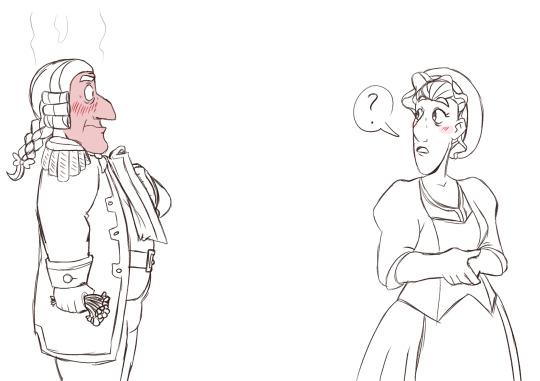
#treasure island#soviet treasure island#treasure island oc#jim hawkins#dr livesey#squire trelawney#captain smollett#doodles#sorry the wiggles of her cap look so bad i have been struggling my entire lifeto draw them and still not triumphed
218 notes
·
View notes
Text
Verdane / ヴェルダン
Verdane (JP: ヴェルダン; rōmaji: verudan) is the forested nation ruled by King Batu in Fire Emblem: Genealogy of the Holy War. The name is a corruption of the French city of Verdun (JP: ヴェルダン), likely inspired by the treaty tied to it. The Treaty of Verdun was signed by the three warring grandsons of Charlemagne: Lothair, Louis, and Charles. Their father, Louis the Pious, had divided the Frankish Empire into three kingdoms for his children, unified by his sovereignty. Upon Louis' passing, the eldest son Lothair wished to reclaim the title of emperor his father's decisions took from him. War broke out between Lothair and his younger brothers - united to deny him the imperial throne. After three years of conflict, Lothair would be bested in the Battle of Fontenoy, and a meeting to establish the Treaty of Verdun would commence. They would declare Lothair unfit for the imperial throne and divide the land into three separate kingdoms: West Francia, Middle Francia, and East Francia, the predecessors to modern France, Italy, and Germany.
The conflict between siblings seen in this period of Frankish history is reflected in the three princes of Verdane. Two of King Batu's sons, Munnir and Cimbaeth, have their goals aligned, while the heir to the kingdom - Jamke - holds opposing values to the rest of the royal family. Similar concepts are found in Munnir's Japanese name, which will be covered at a later date.
10 notes
·
View notes
Text

The Battle of Fontenoy (Detail), by Emile Jean Horace Vernet, 1745
110 notes
·
View notes
Text

Legit got nothing to do (+fearing my mother who has scheduled to look at my shitty exam scores next week) so uhhh decided to conceptualise Dr. Livesey’s old scars from the Battle of Fontenoy (including the nasty one on his chest he got from being wounded in action during that battle), what fun!
#ostrov sokrovishch#treasure island 1988#treasure island#return to treasure island#dr livesey#doctor livesey
27 notes
·
View notes
Photo
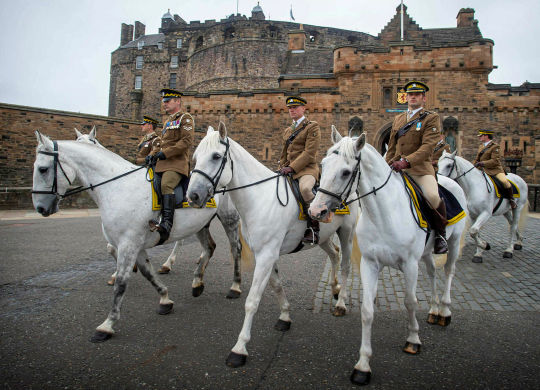
O wae is me my hert is sair, tho but a horse am I.
My Scottish pride is wounded and among the dust maun lie.
I used to be a braw Scots grey but now I'm khaki clad.
My auld grey coat has disappeared, the thocht o't makes me sad.
- Royal Scots Greys, poem recited in reaction to the change their scarlet uniforms and grey horses to khaki.
Formed in 1681, the Royal Scots Greys cavalry unit was Scotland's senior regiment. Its long and distinguished service continued until 1971, when it was merged into The Royal Scots Dragoon Guards.
The regiment was formed as The Royal Regiment of Scots Dragoons in 1681 from a number of existing troops of cavalry. Its first action was the suppression of the Earl of Argyll’s rising, launched in 1685 in support of the Duke of Monmouth’s revolt.
Following the Glorious Revolution (1688), the regiment went over to King William III, fighting for him against the Jacobites in Scotland. It was ranked as the 4th Dragoons in 1692.
The following year, the entire regiment attended a royal inspection in London mounted on ‘greys’ (horses with white or dappled-white hair). This gained it the nickname ‘Scots Grey Dragoons’. However, this only became part of its official title in 1877, when it was renamed the 2nd Dragoons (Royal Scots Greys).
After a period of home service, it joined the War of the Spanish Succession (1701-14). The regiment fought at Schellenberg (1704), Blenheim (1704), the Passage of the Lines of Brabant (1705), Ramillies (1706), Oudenarde (1708), Tournai (1709), Malplaquet (1709) and Bouchain (1711).
It spent a further period on home service until 1742, when it joined the War of the Austrian Succession (1740-48). The regiment deployed to Germany first, fighting at Dettingen (1743). It then moved to Flanders, where it served at Fontenoy (1745), Rocoux (1746) and Lauffeld (1747).
It’s next major battle honour was at the Battle of Waterloo (1815). This was its only Napoleonic battle honour, at which 201 of its men and 228 of its horses were killed attacking a French infantry brigade. In this attack, Sergeant Charles Ewart captured the French 45th Line Infantry Regiment’s eagle. This later became part of the unit’s cap badge.
A long period of home service followed until the Crimean War (1854-56). There, the regiment won two Victoria Crosses charging uphill against 3,000 Russian cavalry at Balaklava (1854).
On returning home, it saw no further active service until the Boer War (1899-1902) in 1899. During this campaign, it camouflaged its white horses with khaki dye. In the years since Balaclava, much had changed about warfare. Gone were the red coats and bearskin shakos. The Scots Greys would now fight wearing khaki. In fact, with the popularity of wearing khaki that accompanied the start of the Boer War, the Scots Greys went so far as to dye their grey mounts khaki to help them blend in with the veldt. It took part in the Relief of Kimberley, fighting at Paardeberg (1900), before joining the advance to Bloemfontein and later Pretoria, service that included the Battle of Diamond Hill (1900). It also fought in the anti-guerrilla campaign in 1901-02.
After returning home in 1905, the Scots Greys stayed in Britain until August 1914, when it moved to France.
It fought on the Western Front as both cavalry and infantry, winning several battle honours including the Retreat from Mons (1914), Marne (1914), Ypres (1914), Neuve Chappelle (1915), Arras (1917) and Amiens (1918).
According to a report in Scottish newspapers of the time it was decided to paint the horses khaki as their grey coats were too visible to German gunners. This gave rise to a comic poem posted above, of which this is the first verse.
**Royal Scots Dragoon Guards set off from Edinburgh Castle
#royal scots greys#royal scots dragoon guards#regiment#british army#scotland#soldier#horses#horse riding#edinburgh castle#military#traditions#military traditions
56 notes
·
View notes
Text

Horace Vernet - The Battle of Fontenoy, 1745, 1828
8 notes
·
View notes
Text
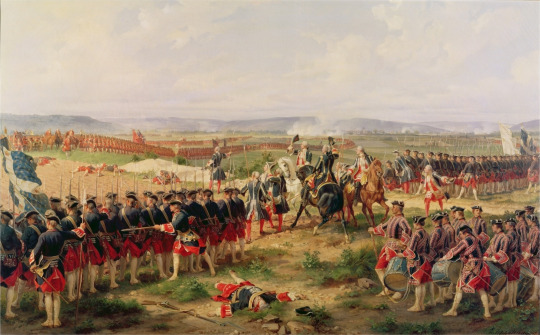
The Battle of Fontenoy, 11 May 1745: 'Lord Charles Hay and Count d'Anterroches: Gentlemen, fire first!'
by Henri Félix Emmanuel Philippoteaux
#battle of fontenoy#art#henri félix emmanuel philippoteaux#france#england#great britain#britain#french#english#british#europe#european#history#battlefield#lord charles hay#count d’anterroches#gardes françaises#english guards#french guards#war of the austrian succession#flanders#fontenoy#tournai#austrian netherlands#netherlands#belgium#joseph charles alexandre d'anterroches#voltaire#count d'anterroches#comte d'anterroches
21 notes
·
View notes
Text
#OTD in Irish History | 11 May:
#OTD in Irish History | 11 May:
1745 – At the Battle of Fontenoy, near Tourney in modern Belgium, the Irish Brigade of the French army under Lieutenant Charles O’Brien repulses the British and wins the day.
1788 – Presbyterian minister, Henry Cooke, is born at Grillagh, near Maghera, Co Derry. Cooke is famous for leading Ulster Presbyterianism away from the free-thinking radicalism which had spawned the United Irishmen’s rising…
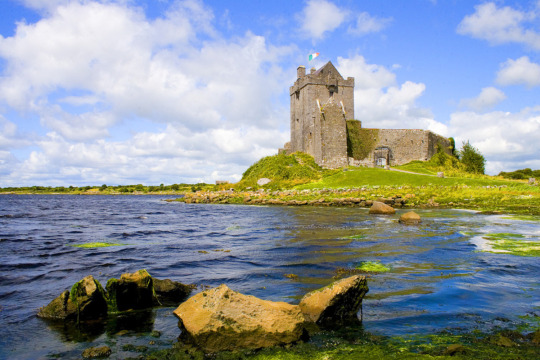
View On WordPress
#irelandinspires#irishhistory ireland#OTD#11 May#1916 Easter Rising#Battle of Fontenoy#History#History of Ireland#Ireland#Irish History#Irish War of Independence#Today in Irish History
4 notes
·
View notes
Text
ah, my old wound from the battle of fontenoy...
#ramblings#my knee hurts like blazes for no conceivable reason but I think I will go out for icecreams anyway#or. well. very probably I will get a little more work done and then I will go out for icecreams later. and some corpse juice.
5 notes
·
View notes
Note
what is the worst injury you have treated?
Oh-
W-Well that would probably be a-
Are you sure you wish to hear this? It is terribly graphic.
Very well...
When I was engaged in combat during the Battle of Fontenoy, a young man fell to one of the French soldier's blades. I was not a medic in that war, merely a soldier, but I used my medical knowledge that I had from study prior to enlisting to try to help him before an actual army medic could take over.
He lay there on the grass, his entrails spilling from his ruptured abdomen and his voice gurgled with every word. He asked me to save him. But I could not.
9 notes
·
View notes
Note
to hell with it. another 🌹🌹🌹🌹🌹 for you sir if you wish
from the aftermath-of-fontenoy livesey/trelawney thing I've been poking at for the past year:
“You’ve been wounded — and when was the last time anyone has seen to it? Don’t tell me you’ve—“ But Livesey cuts him off, sharp and self-righteous, before he can finish.
“I am a doctor, and what is more, there has been no need. I am perfectly capable of tending to such a hurt myself.” Despite his words, Livesey’s tone is carefully bitten out, as if around pain, and his eyes are far more shadowed than Trelawney remembers their having been when Livesey left. The flush that rises to his cheeks out of anger is blotchy, stained rather than smooth.
“You admit to it, then. Does your family know of this? Have you…” Trelawney’s question trails off as he sees Livesey’s face at the reference. “You have not, haven’t you.”
“…you have the right of it, yes.” Livesey nods with a sort of mostly-performed apology that doesn’t at all hide the conviction in his eyes.
“But why?”
“I did not wish them to worry over me. They have troubles enough already without the addition of a son too foolish not to get himself shot.”
“Livesey, you were at the wars! God’s love, man, what did you expect would happen to you in a battle?” Staring in the face of Trelawney’s indignation, Livesey looks first confused, then mildly amused. Quite without intending it, he lets a squeaky chuckle escape him, and before long, both are laughing in earnest.
#em writes stuff#treasure island blogging#MORE! MORE! MORE!#this is one of the ones where I think if I gave it a good shove it could get finished#but it's still a tender fragile baby horse of a fic and I don't want to push it too hard quite yet
10 notes
·
View notes